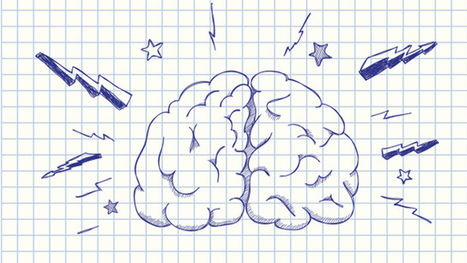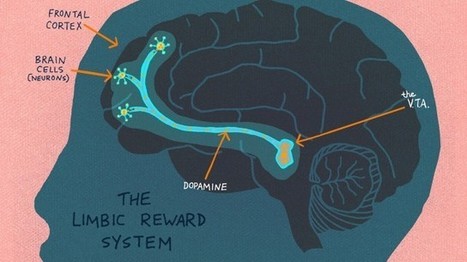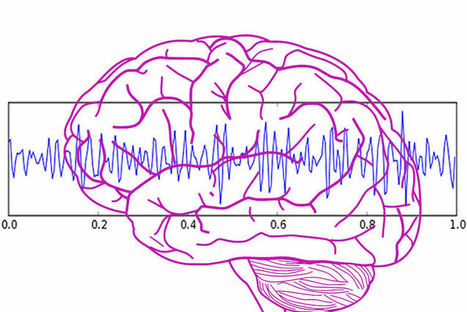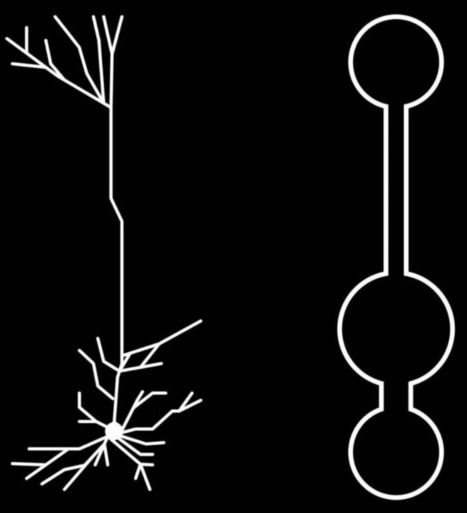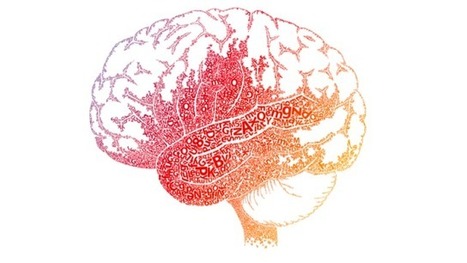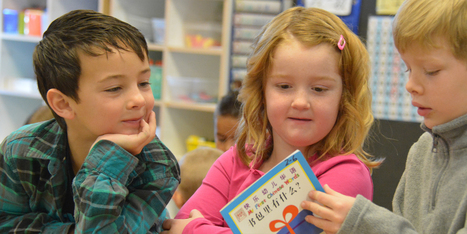 Your new post is loading...
 Your new post is loading...
Early research into the brain-basis of intelligence provided evidence for the idea that brain efficiency, rather than overall brain activity, is related to intelligence. It also provided evidence for the idea that not all brains perform the same functions in the same way. While anatomically it is difficult to distinguish between brains from high and low IQ people, there are observable differences in brain functioning and connectivity related to IQ. For example, the thickness of the corpus callosum (which connects the two brain hemispheres) is related to IQ, and the density and organization of white matter tracts in the frontal and parietal lobes of the brain differ as a function of IQ. Haier and his colleague developed the parieto-frontal integration theory of intelligence, which suggests that the integration of and communication between certain frontal and parietal areas is especially important for intelligence. Recent brain imaging studies have added evidence that supports this theory. Haier reports that scientists are working towards identifying neuromarkers of intelligence as unique as our fingerprints that may lead to more personalized educational programs.
Via Miloš Bajčetić
UNC School of Medicine neuroscientists discover a long-distance brain circuit that controls the production of new neurons in the hippocampus. Research could have implications for understanding and treating many brain disorders, including epilepsy, schizophrenia, depression, and Alzheimer’s disease -------------------------------- Reported as the cover story in Cell Stem Cell, the researchers identified a neurogenesis-controlling brain circuit that runs from near the front of the brain back to the hippocampus, a learning- and memory-related structure. The hippocampus is one of the major sites of neurogenesis in the adult human brain, and the circuit that Song’s team has identified regulates this neuron-producing process.
“This circuit controls the activity of stem cells in the part of the hippocampus where neurogenesis occurs,” said Song, a member of the UNC Neuroscience Center. “Our finding ultimately could have implications for understanding and treating many brain disorders arising from aberrant hippocampal neurogenesis, including epilepsy, schizophrenia, depression, and Alzheimer’s disease.”
Neural stem cells are like stem cells in other tissues and organs – they give birth, if needed, to new cells that replace dead or dying ones. Most of the neurons in the adult brain are wired tightly into complex circuits and are not replaced.
The chief exception is the dentate gyrus (DG) region of the hippocampus. Neurogenesis in the DG occurs throughout adult life and supports the hippocampus’s crucial functions in storing and retrieving memories. DG neurogenesis has been linked to mood as well. In fact, scientists suspect that the mood-improving effects of antidepressant drugs and physical exercise arise at least in part from the boost they give to DG neurogenesis.
Via iPamba, Miloš Bajčetić
New research shows that when we hear stories, brain patterns appear that transcend culture and language. There may be a universal code that underlies making sense of narratives.
Telling and listening to stories is a pastime that spans all cultures. From crime novels to bedtime stories and from ancient legends to spicy romances, humanity loves a good book.
We are all very used to the idea of stories, but the processes at work in the brain are more complex than it seems.
Following a narrative and understanding the story's meaning and themes, as well as the interaction of causes and effects across time, involves challenging cognitive gymnastics. But of course, our brains make it seem effortless.
Neuroscience has made headway in finding out which brain regions help us to understand smaller chunks of language - words and sentences, that is - but we still have a lot to learn about how the brain understands a narrative. Following a story involves a steady accumulation of meaning.
Via Wildcat2030, Miloš Bajčetić
Scientists found that when it comes to grasping complex mathematical concepts, the brain uses different neural networks than it does for language.
Via Suvi Salo, Miloš Bajčetić
New research suggests that curiosity triggers chemical changes in the brain that help students better understand and retain information.
Via Beth Dichter
A key finding from neuroscience research over the last few decades is that non-conscious preparatory brain activity appears to precede the subjective feeling of making a decision. Some neuroscientists, like Sam Harris, have argued that this shows our sense of free will is an illusion, and that lay people would realize this too if they were given a vivid demonstration of the implications of the science (see below). Books have even started to appear with titles like My Brain Made Me Do It: The Rise of Neuroscience and the Threat to Moral Responsibility by Eliezer J. Sternberg.
However, in a new paper, Eddy Nahmias, Jason Shepard and Shane Reuter counter such claims. They believe that Harris and others (who they dub "willusionists") make several unfounded assumptions about the foundations of most people's sense of free will. Using a series of vivid hypothetical scenarios based on Harris’ own writings, Nahmias and his colleagues tested whether people's belief in free will really is challenged by "neuroprediction" - the idea of neuroscientists using brain activity to predict a person's choices, and by the related notion that mental activity is no more than brain activity.
Via iPamba, Miloš Bajčetić
Stanford scientists have shown how the brain changes throughout life, and created a standard curve that can be used to assess whether patients are maturing and aging normally. This resource could help diagnose or monitor people with mental health conditions, learning delays or other diseases.
Via iPamba, Miloš Bajčetić
Researchers detect brief bursts of neural activity oscillating in two specific areas of a mouse brain just before the animal makes a correct choice, either when planning an action or correcting a m...
Via iPamba
|
Deep-learning researchers have found that certain neurons in the brain have shape and electrical properties that appear to be well-suited for “deep learning” — the kind of machine-intelligence used in beating humans at Go and Chess. Canadian Institute For Advanced Research (CIFAR) Fellow Blake Richards and his colleagues — Jordan Guerguiev at the University of Toronto, Scarborough, and Timothy Lillicrap at Google DeepMind — developed an algorithm that simulates how a deep-learning network could work in our brains. It represents a biologically realistic way by which real brains could do deep learning. The finding is detailed in a study published December 5th in the open-access journal eLife. (The paper is highly technical; Adam Shai of Stanford University and Matthew E. Larkum of Humboldt University, Germany wrote a more accessible paper summarizing the ideas, published in the same eLife issue.)
Via Dr. Stefan Gruenwald, Miloš Bajčetić
This phenomenon — testing yourself on an idea or concept to help you remember it — is called the “testing effect” or “retrieval practice.” People have known about the idea for centuries. Sir Francis Bacon mentioned it, as did the psychologist William James. In 350 BCE, Aristotle wrote that “exercise in repeatedly recalling a thing strengthens the memory.”
But the testing effect had been mostly overlooked in recent years. “What psychologists interested in learning and memory have always emphasized is the acquisition part. The taking [information] in and getting it into memory,” Roediger said.
Laypeople — and even experts — tend to think of human memory as a box to be packed with information. “Memory is dynamic, and it keeps changing,” McDaniel said. “And retrieval helps it change.” Learn more / En savoir plus / Mehr erfahren: http://www.scoop.it/t/21st-century-learning-and-teaching/?tag=Brain
Via Gust MEES
When you learn a new technical concept, something happens in your brain, but exactly what has been a mystery until now.
For the first time, Carnegie Mellon University scientists have traced the brain processes that occur during the learning of technical concepts. Published in NeuroImage, the findings reveal how new technical knowledge is built up in the brain during the course of different learning stages. The findings foreshadow the capability to assess the effectiveness of instruction and efficiency of learning by monitoring changes in the brain. Summary from Learning and the Brain Society Newsletter - April 2015 Teaching science to the brain: How the brain learns the way things work For the first time, Carnegie Mellon University scientists have traced the brain processes that occur during the learning of technical concepts. Published in NeuroImage, researchers, scanned the brains of 16 healthy adults as they learned for the first time how four common mechanical systems work. While inside the brain scanner, the participants were shown a series of pictures, diagrams and text that described the internal workings of a bathroom scale, fire extinguisher, automobile braking system and trumpet. The explanation sequence allowed the researchers to examine the participants' brain states after each learning step. The findings reveal how new technical knowledge is built up in the brain during the course of different learning stages and foreshadow the capability to assess the effectiveness of instruction and efficiency of learning by monitoring changes in the brain. Robert Mason lead author explains "This provides evidence that appropriate instruction can bring out the fundamental understanding of how things work at a deep level. In the future, teaching to this deep level as measured in terms of brain representations may be applicable to other disciplines and scientific concepts."
Via iPamba, Miloš Bajčetić
Looking at individual-level information on brain processes could also be useful for figuring out who would best benefit from specific training regimens or learning techniques. Currently, in a project led by cognitive neuroscientist Joseph Hopfinger at the University of North Carolina, we are collecting functional MRI data on college students using the brain-training programs offered by Lumosity, an online brain-training company. Data indicate that Lumosity games can increase cognitive abilities such as working memory, processing speed and attention. We want to identify those individuals most likely to benefit from this training by looking at their brain processes. The results might help us develop cognitive training methods tailored to different types of brains, enabling more people to benefit from the technology.
Instead of comparing brain patterns of those who improve after training with those who do not, we built models of brain processes in individual brains to look for the various processes that predict improvement of cognitive performance after training. This method enables us to separate people who may have scored equally well but who approach cognitive tasks differently, so are heterogeneous in their brain processes. Revealing these potentially various neurobiological underpinnings of improvement will enable researchers to tailor brain-training programs to the needs and deficits of individuals. For example, by looking at patterns that related to no improvement, researchers may be able to develop training protocols that target specific connections among regions. Our work should enable Lumosity to provide products that help a wider group of consumers. Having even better tools for keeping the mind sharp will become increasingly important as the nation’s aging population experiences the expected cognitive decline.
Via Miloš Bajčetić
"Researchers have long been searching for better ways to learn. In recent decades, experts working in cognitive science, psychology, and neuroscience have opened new windows into how the brain works, and how we can learn to learn better. In this program, we look at some of the big ideas coming out of brain science. We meet the researchers who are unlocking the secrets of how the brain acquires and holds on to knowledge. And we introduce listeners to the teachers and students who are trying to apply that knowledge in the real world."
Via Beth Dichter
For those who think there are not enough hours in the day, researchers may have just offered you a solution. The brain can continue tasks even while asleep, a study finds. Texting not included, alas.
Via iPamba, Miloš Bajčetić
Researchers develop new technology which allows for more accurate mapping of the connections within white matter tissue in the human brain. Roughly 100 trillion connections between neurons make it possible for the brain to function. Psychology Professor Brian Wandell’s group has devised a technique for mapping these connections with greater accuracy than ever before. Two different algorithms produce two very different estimates of the shape of the same white matter connection in Franco Pestilli’s brain. The LiFE software, developed in the Wandell Lab, aims to produce more precise estimates. Credit Wandell Lab.
Via iPamba, Miloš Bajčetić
|
 Your new post is loading...
Your new post is loading...
 Your new post is loading...
Your new post is loading...














